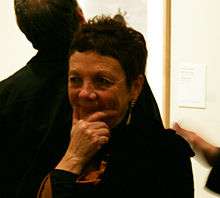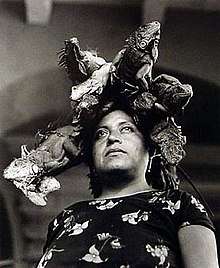Graciela Iturbide
| Graciela Iturbide | |
|---|---|
 | |
| Born |
Graciela Iturbide 1942 Mexico City, Mexico |
| Nationality | Mexican |
| Education | Centro Universitario de Estudios Cinematográficos, Universidad Nacional Autónoma de México |
| Known for | Photography |
| Website |
www |
Graciela Iturbide (born 1942) is a Mexican photographer. Her work has been exhibited internationally and is included in many major museum collections such as the San Francisco Museum of Modern Art and the Getty.[1]
Biography
Iturbide was born in Mexico City, Mexico in 1942, to traditional Catholic parents. The eldest of thirteen children,[2] she attended Catholic school and was exposed to photography early on in life. Her father took pictures of her and her siblings, and she got her first camera when she was 11 years old. When she was a child, her father put all the photographs in a box; Iturbide later said "it was a great treat to go to the box and look at these photos, these memories."[3]
She married the architect Manuel Rocha Díaz in 1962 and had three children over the next eight years: sons Manuel and Mauricio, and a daughter, Claudia, who died at the age of six in 1970. Manuel is now a composer and sound artist and has lectured at California College of the Arts.[4] Mauricio took after his father and became an architect.[5]
Photography career
Iturbide turned to photography after the death of her six-year-old daughter, Claudia, in 1970. She studied at the Centro Universitario de Estudios Cinematográficos at the Universidad Nacional Autónoma de México with the intention of becoming a film director. She realized how drawn she was to photography which was Manuel Álvarez Bravo’s area of expertise. He was a teacher at the university as well as a cinematographer, photographer and became her mentor.[2] She traveled with Bravo between 1970 and 1971 and learned that "there is always time for the pictures you want."[6] In 1971 she was awarded the W. Eugene Smith Grant, and a scholarship at the Guggenheim College. Iturbide photographs everyday life, almost entirely in black-and-white. She was inspired by the photography of Josef Koudelka, Henri Cartier-Bresson, Sebastiao Salgado and Álvarez Bravo.[7] Her self-portraits especially reflect and showcase Bravo’s influence and play with innovation and attention to detail.[8] She became interested in the daily life of Mexico's indigenous cultures and people (the Zapotec, Mixtec, and Seri[8]) and has photographed life in Mexico City, Juchitán, Oaxaca and on the Mexican/American border (La Frontera). With focus on identity, sexuality, festivals, rituals, daily life, death and roles of women; Iturbide’s photographs share visual stories of cultures in constant transitional periods. There’s also juxtaposition within her images between urban vs rural life and indigenous vs modern life.[9] Iturbide's main concern has always been the exploration and investigation of her own cultural environment.[8] She uses photography as a way of understanding Mexico; combining indigenous practices, assimilated Catholic practices and foreign economic trade under one scope.[10]
"Mujer Ángel"
In 1978, Iturbide was commissioned by the Ethnographic Archive of the National Indigenous Institute of Mexico to work on a series about Mexico’s Seri Indians - a group of fisherman living in the Sonora desert along the Arizona/Mexico border. She was in Punta Chueca for a month and a half working on the series. There were about 500 people within the community. It was while working for this series that her photograph called "Mujer Ángel" was taken.[11] The image depicts a Seri woman while on an expedition to a cave with indigenous paintings. The woman “looked as if she could fly off into the desert” and was carrying a tape recorder exchanged for handicrafts by Americans.[11] "Mujer Ángel" was used by the politically charged metal group Rage Against The Machine for their single "Vietnow" in 1997.
In 1979, Iturbide was asked by painter Francisco Toledo to photograph the Juchitán people who form part of the Zapotec culture native to Oaxaca, Mexico. It is traditionally a matriarchal society in which the women are economically, politically, and sexually independent. The women run the market and men are not allowed to enter with the exception of gay men they call muxes in Zapotec language.[1] This experience as a photographer shaped Iturbide's views on life, making her a strong supporter of feminism. Iturbide worked on this series for almost 10 years, ending in 1988. This collection resulted in the book Juchitán de las Mujeres.[12]
"Nuestra Señora de Las Iguanas" and "Magnolia"

Some of the inspiration for her next work came from her support of feminist causes. Her well-known photograph,[13] "Nuestra Señora de Las Iguanas" (Our Lady of the Iguanas) came from her photo essay "Juchitán of the Women (1979–86)" which was also shot in Juchitán de Zaragoza.[14] This icon became so popular that there is a statue of this woman made in Juchitán as well as murals and graffiti.[1] Filmmakers Susan Streitfeld and Julie Hébert used this photo as an icon in their film Female Perversions (1996).[6]:4 Her work in Juchitán was not only about women, however: she also shot "Magnolia", a photo of a man wearing a dress and looking at himself on a mirror, which some cite as evidence that Iturbide also explored sexuality among Mexicans.
Iturbide has also photographed Mexican Americans in the White Fence (street gang) barrio of Eastside Los Angeles as part of the documentary book A Day in the Life of America (1987). She has worked in Argentina (in 1996), India (where she made her well-known photo, "Perros Perdidos" (Lost Dogs)), and the United States (an untitled collection of photos shot in Texas).
One of the major concerns in her work has been "to explore and articulate the ways in which a vocable such as 'Mexico' is meaningful only when understood as an intricate combination of histories and practices."[15]
She is a founding member of the Mexican Council of Photography. She continues to live and work in Coyoacán, Mexico.
In awarding her the 2008 Hasselblad Award, the Hasselblad Foundation said:
Graciela Iturbide is considered one of the most important and influential Latin American photographers of the past four decades. Her photography is of the highest visual strength and beauty. Graciela Iturbide has developed a photographic style based on her strong interest in culture, ritual and everyday life in her native Mexico and other countries. Iturbide has extended the concept of documentary photography, to explore the relationships between man and nature, the individual and the cultural, the real and the psychological. She continues to inspire a younger generation of photographers in Latin America and beyond.[16]
The largest institutional collection of Iturbide's photographs in the United States is preserved at the Wittliff collections, Texas State University, San Marcos, TX.[17]
Publications
- Images of the spirit. New York: Aperture Foundation, 1996. ISBN 0-89381-681-7.
- La Forma y la Memoria = "Form and Memory". Monterrey, Mexico: Museo de Arte Contemporáneo de Monterrey, 1996. ISBN 978-9686623321.
- Eyes to fly with: portraits, self-portraits, and other photographs. Austin, University of Texas, 2006. ISBN 0-292-71462-9.
- Iturbide. Madrid: tf. editores, 2003. ISBN 84-96209-48-2.
- Graciela Iturbide. London: Phaidon, 2006. Edited and with an essay by Marta Gili. ISBN 9780714845708. Phaidon, 2011.
- Torrijos: The Man and the Myth. Madrid: Umbrage, 2008. ISBN 978-1-884167-68-3.
- Graciela Iturbide: Juchitán. Los Angeles: J. Paul Getty Museum, 2007. ISBN 9780892369058. Barcelona: RM, 2011. ISBN 978-8492480531.
Awards
- 1987: W. Eugene Smith Grant from the W. Eugene Smith Memorial Fund
- 1988: Guggenheim Fellowship from the John Simon Guggenheim Memorial Foundation[18]
- 1990: International Grand Prize, Hokkaido, Japan
- 1991: Award Recontres Photographiques, Arles, France
- 1998: First prize, Mois de la Photo, France
- 2008: Hasselblad Foundation Photography Award[19]
Exhibitions (selected)
- 1980: Graciela Iturbide, New Mexico
- 1990: External Encounters, Internal Imaginings: The Photographs of Graciela Iturbide, at the Museum of Modern Art in San Francisco, CA
- 1991: Rencontres d'Arles Festival, Arles, France
- 1997-1998: Images of Spirit at the Philadelphia Museum of Art, Philadelphia, PA
- 2003: Pajaros et Paisajes (Birds and Sights), Robert Miller Gallery, New York City
- 2003: Pajaros et Paisajes, OMG Gallery for Contemporary Art, Düsseldorf, Germany
- 2007-2008: The Goat's Dance: Photographs by Graciela Iturbide, J. Paul Getty Museum, Los Angeles, LA
- 2008: Torrijos: The Man and the Myth,[20] Americas Society, New York
- 2011: Rencontres d'Arles Festival, Arles, France
- 2011: Retrospective, Pinacoteca, São Paulo, Brazil[21]
- 2015: Naturatta | Baño de Frida, Helinä Rautavaara Museum, Espoo, Finland
- 2016: Graciela Iturbide: A Lens to See, Ruiz-Healy Art, San Antonio, TX, for Fotoseptiembre USA
- 2017: Revolution and Ritual: The Photographs of Sara Castrejon, Graciela Iturbide, and Tatiana Parcero, Ruth Chandler Williamson Gallery at Scripps College, Claremont, CA
Collections
Iturbide's work is held in the following permanent collections:
- Brooklyn Museum, Brooklyn, NY[22]
- Museum of Modern Art, New York City[23]
- Centre Georges Pompidou, Paris[24]
- Los Angeles County Museum of Art, Los Angeles, CA[25]
- National Museum of Women in the Arts, Washington, D.C.[26]
- San Francisco Museum of Modern Art, San Francisco, CA[27]
- J. Paul Getty Museum, Los Angeles, CA[28]
- Wittliff collections, Texas State University, San Marcos, TX[17]
- Yale University Art Gallery, New Haven, CT[29]
Further reading
- Universidad Nacional Autónoma de México (1980). 7 portafolios Mexicanos: exposición por diversos países, Centro Cultural de México, abril-mayo de 1980. UNAM Difusión Cultural - in Spanish
References
- 1 2 3 "Graciela Iturbide talks about going viral, L.A. cholos and shooting Frida Kahlo's bathroom". Los Angeles Times. ISSN 0458-3035. Retrieved 2017-11-12.
- 1 2 "Graciela Iturbide (Mexican, born 1942) (Getty Museum)". The J. Paul Getty in Los Angeles. Retrieved 2017-11-12.
- ↑ Iturbide, Graciela; Bradu, Fabienne (2006). Eyes to Fly With: Portraits, Self-Portraits, and Other Photographs. Austin: University of Texas Press. p. 3.
- ↑ "Lecture by Manuel Rocha Iturbide | California College of the Arts". www.cca.edu. Retrieved 2017-11-12.
- ↑ "Iturbide Studio in Mexico City by Taller Mauricio Rocha + Gabriela Carrillo". Architectural Review. Retrieved 2017-11-12.
- 1 2 Iturbide, Graciela; Keller, Judith (2007). Graciela Iturbide: Juchitán. Los Angeles: The J. Paul Getty Museum. p. 1.
- ↑ http://www.fototapeta.art.pl/2013/gta-e.php.
- 1 2 3 "Graciela Iturbide".
- ↑ "A Photo Teacher".
- ↑ "ARTIST Graciela Iturbide".
- 1 2 "Graciela Iturbide's best photograph: a Mexican Seri woman".
- ↑ "Graciela Iturbide".
- ↑ "Day of the Iguanas". Smithsonian (magazine), September 2008. Accessed 9 March 2017
- ↑ "Nuestra Señora de las Iguanas (Our Lady of the Iguanas), Juchitán, Oaxaca". Brooklyn Museum. Accessed 9 March 2017.
- ↑ Iturbide, Graciela; Tajeda, Roberto; López Austin, Alfredo (1996). Images of the Spirit. New York: Aperture Foundation. p. 12.
- ↑ The 2008 Hasselblad Award Winner - Graciela Iturbide, Hasselblad Foundation, 2008, archived from the original (– Scholar search) on June 3, 2008, retrieved 2008-06-17
- 1 2 Graciela Iturbide Photographs at The Wittliff Collections, Texas State University, San Marcos, TX. Retrieved 3 June 2016.
- ↑ "Graciela Iturbide". John Simon Guggenheim Memorial Foundation. Retrieved 26 December 2014.
- ↑ Graciela Iturbide Wins Hasselblad Foundation Photography Award, ARTINFO, March 20, 2008, retrieved 2008-05-20
- ↑ Torrijos: The Man and the Myth. Retrieved 18 August 2014.
- ↑ "Archived copy". Archived from the original on 2011-07-06. Retrieved 2011-07-06.
- ↑ "Graciela Iturbide – Mexican, born 1942". Brooklyn Museum. Accessed 9 March 2017
- ↑ "Graciela Iturbide: Mexican, born 1943". Museum of Modern Art. Retrieved 2017-03-09.
- ↑ "Graciela Iturbide". Centre Georges Pompidou. Accessed 9 March 2017
- ↑ "Graciela Iturbide". Los Angeles County Museum of Art. Accessed 9 March 2017
- ↑ "Graciela Iturbide: Born 1942". National Museum of Women in the Arts. Accessed 9 March 2017
- ↑ "Graciela Iturbide: Mexican: 1942, Mexico City, Mexico". San Francisco Museum of Modern Art. Accessed 9 March 2017
- ↑ "Graciela Iturbide". J. Paul Getty Museum. Accessed 9 March 2017
- ↑ "Overview and Highlights". artgallery.yale.edu. Retrieved 2017-03-08.